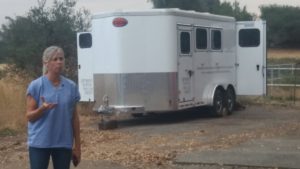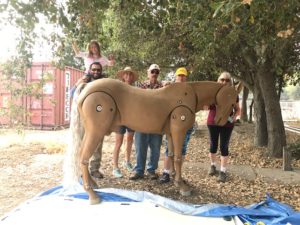

Thank you to all who attended our September training session on first response to incidents involving animals. I thought it would be helpful to provide a synopsis of some of the key points from that training.
Remember, horses are prey animals and that they are predictably unpredictable when adrenalized. As we work to integrate First Responders with DVMs to address the welfare of animals involved in accidents and disasters, it is helpful to keep some very important key safety issues in mind. Upon arrival, think SRPR.
S: Scene control
What can you do as an individual to control the scene and remove adrenaline from the equation?
• Locate a buddy horse and place in line of sight
• Offer hay or feed to distract the horse
• Manage the owner reactions- fear and anxiety are transferable
• Lower ER lights, noises, radios- all of which are stimulating
R: Risks
Try to evaluate personal risk and animal risk.
• Are gates closed, sharp objects moved, is there a safe quiet spot to move the horse to if recumbent? Explore the site before initiating action- what trouble lurks around the corner?
• Do I have the right personal protective equipment to help? Heavy shoes, gloves, helmet?
• Is my body in the safe zone (horse’s front left shoulder area is safe). Avoid positioning directly in front or behind horse (blind spots) and realize standing kick zone is from mid rib cage to tail. Recumbent kick zone: head to base of tail, leg side. Are my knees bent? Are my hands free of tangled or gathered rope? Are other horses secured and at a safe distance?
• What is the horse’s body, behavior telling me? Is it approachable? Think head and tail elevation, are there signs of adrenaline?
• Increased risk: Trapped, lone horse, stallions, mares with foals, injured animal, excited herd environment. Apparently quiet, trapped horse will thrash and rest without warning.
P: Plan
How do we get this animal from a place of risk to a place of safety? Work with professionals to create a plan with an end goal in mind. Make sure DVM on route. Listen to first responders. Follow Incident Command. Do not risk your own safety- wait for sedation.
• Consider safety of plan. Leave the hazard in the box until you have a safe place to recover, move it to.
• Consider viability of rescue. Allow DVM assessment if possible
• Loose horse on road, in water…get a buddy in line of sight, use food, find an open field, gate to herd it to.
• Manage traffic, noise, stimulation
• Assign safety officer until ICS established
R: Resources
What do we need to safely and effectively accomplish the plan?
• Personnel- DVM- sedation and anesthesia
• Fire team for extrication- ropes, tools, radios, power, plan
• Mutual aid: Sheriff, Animal Control, USAR, CHIP
• PPE- for all. Durable shields to keep operators safe around legs. Helmets, boots, gloves.
• Rescue equipment: Glide, Large Animal Lift, Straps, Strap guides, VER trailer with Winch and ramp.
• Referral hospital for critical care post rescue.
Again, thank you to those who joined us. We look forward to seeing you all in future training sessions. See our Events Calendar for future sessions.
Claudia Sonder, DVM